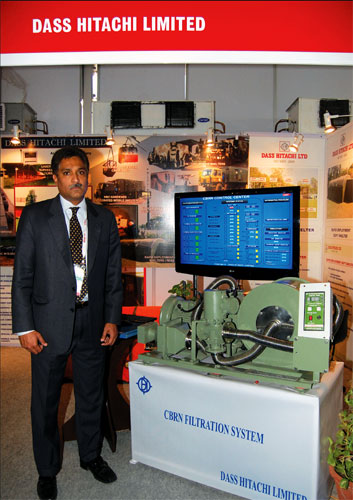|
 Pakistan
remains the real wildcard in the Asian and world
nuclear club. New Delhi’s concerns about security
of Pakistan’s nuclear weapons, particularly due
to its ISI’s links with terrorists and continued
terrorist violence emanating from Pakistan, are
high. The 26/11 Mumbai attacks by Pakistani terrorists
have made the Indian home and defence ministries
sit up and think of such eventualities. Pakistan
remains the real wildcard in the Asian and world
nuclear club. New Delhi’s concerns about security
of Pakistan’s nuclear weapons, particularly due
to its ISI’s links with terrorists and continued
terrorist violence emanating from Pakistan, are
high. The 26/11 Mumbai attacks by Pakistani terrorists
have made the Indian home and defence ministries
sit up and think of such eventualities.
“Indian army is looking for a single window
purchase wherein platform, outriggers, shelters,
masts, CBRN filtration systems, gensets, and mounting
racks are all part of the integrated system. The
Army is moving from a static to mobile mode,”
said Pradeep Dass, Executive Director, Dass Hitachi.
With the possibility of nuclear and biological
weapons falling in the hands of terrorists being
real, the civilians in densely populated region
have come up as potential targets. The current
reality of the use of modern biotechnology, new
chemical agents, and the recent relatively easier
accessibility for fissile materials and technology
for making tactical nuclear weapons, presents
governments with a new reality and a changed CBRN
scenario.
The premier military research organization Defence
Research and Development Organisation (DRDO) has
inked two Memorandums of Understanding with Dass
Hitachi for CBRN protection systems. “Our CBRN
products are being used in large numbers in the
army and we are the only suppliers. It is a planning
of the army to deter such attacks and our integrated
field shelters for 30 persons, completely self
contained and protected are present in large scale
in the army,” Dass told India Strategic.
The nuclear component of the future CBRN warfare
remains an inevitable concern of future military
strategies. The prospective increase in the number
of nuclear club countries does not necessarily
mean they will be signatories of the non-proliferation
treaty (NPT). So deterrence against it becomes
pivotal. Dass informed: “We are also supplying
CBRN filtration system for mobile application.
Rapid deployable soft shelters and CBRN protected
mobile shelters will also be visible in sensitive
zones.”
Currently there are over 35,000 nuclear weapons
in the world arsenal, equivalent in the destructive
power to over 10,000,000 kilotons of TNT, capable
of creating approximately one mi l l ion Hiroshimas.
The hidden arsenals of target nations and the
command posts are not easily identifiable or accessible
by conventional weapons. But the concepts of nuclear
deterrence do not apply to clandestine nuclear
terrorist networks, sponsored by state or nonstate
operators.
To effectively deter terrorists’ CBRN proliferation
and warfare, it is crucial to understand the types
of CBRN weapons and devices that a group is likely
or unlikely to employ in its warfare, their motivations
and strategies in identifying potential targeting,
and the internal and external hurdles that they
need to overcome to pursue such warfare.
Dass stressed: “The complete CBRN protection
scheme for static application was in the prototype
stage and is yet to be introduced into service.
It should also be helpful in fighting against
guerrilla forces.” The company is also interacting
with the government for CBRN protection to the
commonwealth games to be held in India this year.
He informed: “We specialise in nuclear, biological
and chemical (NBC) protection and are the only
indigenously approved producer of NBC ventilation
systems. We make underground, self-contained,
NBC-protected, portable shelters— designed to
help Indian forces withstand a nuclear attack
in a ‘near-miss’ situation—in large numbers. The
shelters include a decontamination module and
a utility module with living accommodation and
facilities sustainable for ninety six hours. The
shelter has been successfully evaluated for a
blast of requisite yield under actual field conditions.”
DRDO has announced several major steps to revamp
its capabilities against nuclear, biological and
chemical attack. The DRDO has reportedly invented
a ‘Portable Gas Chromatograph’ which can detect
chemical warfare agents. This has been converted
into a chemical paper which will be placed on
the uniform and any change in colour will enable
the soldiers to detect chemical contamination.
It has invented an antigen-based diagnostic kit
to aid in the diagnosis of typhoid, leptospirosis,
dengue, H1N1, malaria, plague, anthrax and other
diseases.
The newly invented recce vehicles and remotely-operated
vehicle Daksh will also aid in identifying chemically
contaminated areas and removing any potential
radiation source. Mobile decontamination vehicles
have also recently been announced by the DRDO.
India suddenly seems to be gearing up for an
unknown war and there is a definite technological
shift in strategy from conventional to CBRN warfare.
With uncertainties looming large in the form of
undeclared war, it seems to be the right step
ahead.
|